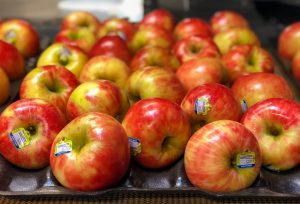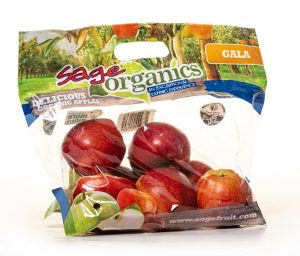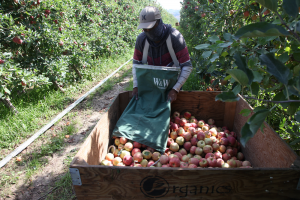Washington Expects Bumper Organic Apple Crop
Coming off a year of short supplies due to several weather events, the Washington apple industry has forecast a very large crop compared to 2022-23, with organic apple volume predicted to be 66 percent greater this season.
The Washington State Tree Fruit Association’s official estimate has put the total crop at 134 million 40-pound cartons, which represents almost a 29 percent increase over the 2022 crop and is only about 6 percent below the all-time record achieved in 2014/15. The organic apple volume has been pegged at more than 21.1 million boxes, which would be about 5.5 million boxes greater than the 2020/21 record organic crop of 15.6 million cartons.
Tim Kovis, director of communications for the association, cautioned that the final organic packout may not match this early season forecast, but it almost certainly will represent a new organic volume record.
“Last year was an extremely short Washington apple crop after multiple weather events impacted the crop. Snow during bloom and hail … this crop had it all,” said Brianna Shales, marketing director of Stemilt Growers in Wenatchee. “The ’23-’24 crop is a different story with ideal weather conditions this growing season and growth in organic volumes that is coming following last year’s short crop but also because of an increase in organic acreage. At Stemilt, we’ve strategically grown our share of organic apples. We will be up 48 percent on organic apples from last year, with approximately 25 percent of our entire crop estimated to be grown/certified organic.”
Shales said harvesting began in early August with organic Galas, which will soon be followed by organic Honeycrisp and SweeTango. “As we round into September, more varieties become available, and then retailers can take advantage of regular promotions on the organic apple category,” she said. “With the increase in organic apples over last year, we are excited about the potential for promotions this year and next.”
She added that the overall volume increase will positively impact virtually every variety. “Most notably, Fuji, Gala, Cosmic Crisp, and Honeycrisp will have larger shares of organic than last year,” she said, noting that there is also a significant increase in newer varieties under the “other varieties” category. Comprised of many proprietary apple varieties, Shales said the organic volume of the “other varieties” category has been estimated to jump from 1.1 million boxes to 8.4 million.
“At Stemilt, we’re growing more modern varieties organically and have substantial increases in organic Cosmic Crisp, organic SweeTango, and organic Honeycrisp,” she added.
Discussing the consumer trend on organic apples, Shales said that is difficult to gauge because of last year’s short crop, which logically resulted in total organic apple reduced consumption. “Overall organic apple dollars and volumes were down year over year. Organic produce saw dollars up but volume down for most of the year,” she said. “Recent data on organic produce show that volume is starting to grow again [up about 1 percent last quarter], and the trend is reversing. We are optimistic that with more organic apples in this crop year, we will be able to supply and promote organics with retailers to help grow the category with consumers.”
Kaci Komstadius, vice president of marketing for Sage Fruit Co. in Yakima, is equally excited about this year’s organic apple crop and the opportunity to grow sales. “At Sage Fruit, our organic program continues to grow to meet retail and consumer demand. Not only are we planting new acreage of organic orchards, but we are actively transitioning many of our conventional orchards,” she said. “Like the industry, we will have a sizable increase in our organic volume this season across all varieties.”
Komstadius said Sage Fruit has a full lineup of organic apple options. “Our organic varieties include Gala, Honeycrisp, Granny Smith, Fuji, Ambrosia, SugarBee, Pink Lady, and Cosmic Crisp. Over the course of the season, there will be excellent promotional opportunities at retail,” she said. “This season, Sage Fruit will see a significant increase in volume on several varieties, most notably Honeycrisp and SugarBee.”
Komstadius is also excited about the organic category in general and growth potential. “Organic demand remains high and should continue to do so,” she said. “Roughly 52 percent of organic consumers are millennials, and they account for 30 percent of the US population. The majority of millennials who are purchasing organic items are also parents.”
Catherine Gipe-Stewart, director of marketing for Domex Superfresh Growers in Yakima, said this year’s large crop should result in excellent quality. “This is a year where quality will certainly be king, or so it seems so far,” she said. “We are seeing clean, non-blemished fruit across the board from organic Gala and Honeycrisp to Grannys and Cosmic Crisp. The weather in May provided ideal growing conditions with strong bloom and pollinating weather. We are seeing that most varieties thinned out nicely, encouraging nice size and high quality.”
Superfresh Growers is mirroring the overall state’s organic crop as it has forecasted its own organic production to be up more than 60 percent, led by a 165 percent increase in Cosmic Crisp, 92 percent increase in Granny Smith, and 70 percent increase in Honeycrisp.
“We will have plenty of volume to promote this year,” Gipe-Stewart said. “One of our biggest messages this year is to not repeat last year’s merchandising plan for apples! We have a completely different crop with plenty of volumes to support promotions. Superfresh will have organics all year long. Set ads throughout the year, giving organic apples lots of prominent space to move volume and earn dollars.”
Superfresh is very high on organic Honeycrisp and Cosmic Crisp. “Honeycrisp is king, and Cosmic Crisp is attracting the same consumer profiles,” she said. “We witnessed last year that consumers are willing to switch between the two varieties. Promoting together or alternating ads between the two can help drive apple category sales.”
Gipe-Stewart said one big trend in the organic apple category is the growth of proprietary varieties. “Proprietary apple growth is needed as organic core apple varieties have had a downward trend last year, though shorter organic crops last year were a huge factor in that,” she said. “Washington and the Pacific Northwest drive organic consumption in apples. With a year where the state is up 61 percent, there is ample room to expand shelf space for organics and give them the front of store and incremental space they deserve.”
For more news of interest to the produce industry, subscribe to Gourmet News.


